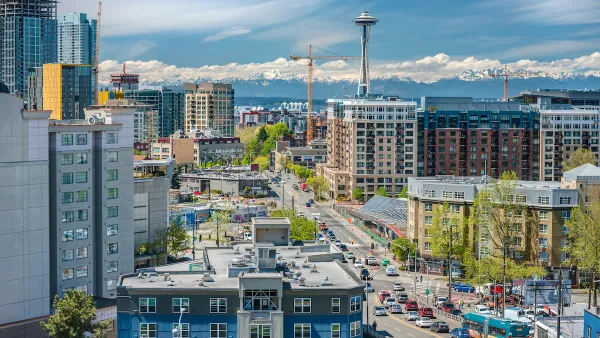Roger Valdez gives his take on the new obstructionism that is dominating public participation and holding up much-needed growth in Seattle and elsewhere.
At the heart of efforts to guide future growth in the city, Valdez sees an irreconcilable, four-man tug-of-war between "labor, neighborhoods, developers, and environmentalists." Faced with proposals that might alter the character of their single-family communities even modestly, neighborhood groups in Seattle staunchly oppose planning that would reduce housing costs, improve transit, make neighborhoods more walkable, and lift redundant legal barriers to development.
It's a dramatic change from the way neighborhood activists used to do business, Valdez argues. "Seattle's neighborhoods are ascendant and they are abusing their power, shifting from fighting for things to fighting against them."
Valdez laments, "What happened? How did earnest, liberal, Birkenstock-wearing activists pushing for parks, play equipment, sidewalks, and kiosks turn into affluent, highly motivated saboteurs of new development, change, and density? Three things happened in the last two decades that shifted neighborhoods from the 'what we want' caucus to the 'what we won't' lobby:"
- The Housing Market – In the absence of developable land, homeowners stand to gain by making their communities more exclusive and scarce.
- Organizing – In the 90s, the Department of Neighborhoods learned to mobilize disadvantaged communities by focusing the discussion on emotionally-charged phrases and images. Now, affluent neighborhoods rally around concerns over "gentrification" to quite the contrary effect.
- A Compliant City Council – Politicians are too eager to satisfy the demands of "a large, affluent, and motivated group of neighborhood activists," even at the expense of healthy community growth.
"This balance of power can't shift without courage, by developers, unions, and environmentalists who must support a louder, stronger voice for dense, transit-oriented neighborhoods, not just intellectual dialogues and power point presentations."
FULL STORY: Seattle neighborhoods fight needed land use reform, density

National Parks Layoffs Will Cause Communities to Lose Billions
Thousands of essential park workers were laid off this week, just before the busy spring break season.

Retro-silient?: America’s First “Eco-burb,” The Woodlands Turns 50
A master-planned community north of Houston offers lessons on green infrastructure and resilient design, but falls short of its founder’s lofty affordability and walkability goals.

Delivering for America Plan Will Downgrade Mail Service in at Least 49.5 Percent of Zip Codes
Republican and Democrat lawmakers criticize the plan for its disproportionate negative impact on rural communities.

Test News Post 1
This is a summary

Test News Headline 46
Test for the image on the front page.

Balancing Bombs and Butterflies: How the National Guard Protects a Rare Species
The National Guard at Fort Indiantown Gap uses GIS technology and land management strategies to balance military training with conservation efforts, ensuring the survival of the rare eastern regal fritillary butterfly.
Urban Design for Planners 1: Software Tools
This six-course series explores essential urban design concepts using open source software and equips planners with the tools they need to participate fully in the urban design process.
Planning for Universal Design
Learn the tools for implementing Universal Design in planning regulations.
EMC Planning Group, Inc.
Planetizen
Planetizen
Mpact (formerly Rail~Volution)
Great Falls Development Authority, Inc.
HUDs Office of Policy Development and Research
NYU Wagner Graduate School of Public Service





























